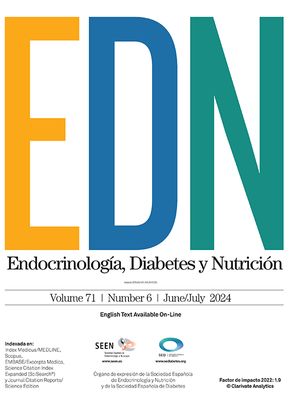Genetic testing of the RET proto-oncogene allows for early diagnosis of multiple endocrine neoplasia syndrome type 2 and establishes a correlation between genotype and clinical manifestations. The purpose of this study was to demonstrate the benefits of early diagnosis with genetic testing followed by prompt surgery for curing medullary thyroid carcinoma (MTC) as compared to later diagnosis with serum calcitonin.
Patients and methodA retrospective, descriptive study of 8 members of a family with MEN 2A due to C634Y mutation. We performed serum calcitonin screening until 1999, and subsequently RET genetic testing. The carriers underwent total thyroidectomy, periodic determination of calcitonin, urinary metanephrines, calcium, and phosphorus, and cervical and abdominal imaging techniques.
ResultsFive patients were diagnosed by calcitonin familial screening and at the time of writing all of them had high calcitonin levels. Three patients were diagnosed by genetic testing (an adult and two children) and were free of disease. Calcitonin was closely monitored in the children, who underwent surgery when it started to rise at 6 and 10 years of age respectively, nodular C-cell hyperplasia having been found in both. Three of the eight carriers developed bilateral and asynchronous pheochromocytoma, half had normal urinary metanephrine levels and two also had MTC. No patient had biochemical data suggesting hyperparathyroidism although in one patient multiple parathyroid adenomas were found at thyroidectomy.
ConclusionsRET genetic analysis allowed for early diagnosis and treatment with no development of MTC in our patients, gave early guidance about the type of surgery required, and allowed for genotype-phenotype correlation. It demonstrates how genetic change is associated with a pathology we can prevent and manage, thereby improving the prognosis of our patients.
El estudio genético del protooncogén RET permite un diagnóstico precoz del síndrome de neoplasia endocrina múltiple tipo 2 y establece una correlación entre el genotipo y las manifestaciones clínicas. El objetivo del presente trabajo es demostrar los beneficios del diagnóstico precoz por estudio genético seguido de tratamiento temprano en la curación del carcinoma medular de tiroides (CMT) frente al diagnóstico más tardío con la calcitonina sérica.
Pacientes y métodoEstudio descriptivo retrospectivo de 8 miembros de una familia con MEN2A por mutación C634Y. Se realizó despistaje con calcitonina sérica hasta 1999 y estudio genético de RET posteriormente. A los portadores se les realizó tiroidectomía total y determinaciones periódicas de calcitonina, metanefrinas urinarias, calcio, fósforo y pruebas de imagen a nivel cervical y abdominal.
ResultadosLos 5 pacientes diagnosticados por despistaje familiar con calcitonina presentan en la actualidad cifras de calcitonina elevadas. Los 3 diagnosticados por estudio genético (un adulto y dos niños) se encuentran libres de enfermedad. En los niños se monitorizó la calcitonina y se les intervino cuando esta comenzó a elevarse, a los 6 y 10 años respectivamente, hallándose hiperplasia nodular de células C en ambos. De los 8 afectos 3 presentaron feocromocitomas, bilaterales y asincrónicos, la mitad con metanefrinas urinarias normales y dos simultáneos al CMT. Ningún paciente presentó alteraciones bioquímicas sugestivas de hiperparatiroidismo aunque en uno se descubrieron adenomas paratiroideos múltiples durante la cirugía tiroidea.
ConclusionesEl estudio genético de RET ha conseguido el diagnóstico y tratamiento precoces y por tanto la curación del CMT en nuestros pacientes, orientándonos sobre el momento y tipo de cirugía adecuados y permitiendo correlacionar fenotipo-genotipo, ejemplificando cómo una alteración genética se asocia a patología que podemos prever y manejar mejorando el pronóstico de nuestros pacientes.




